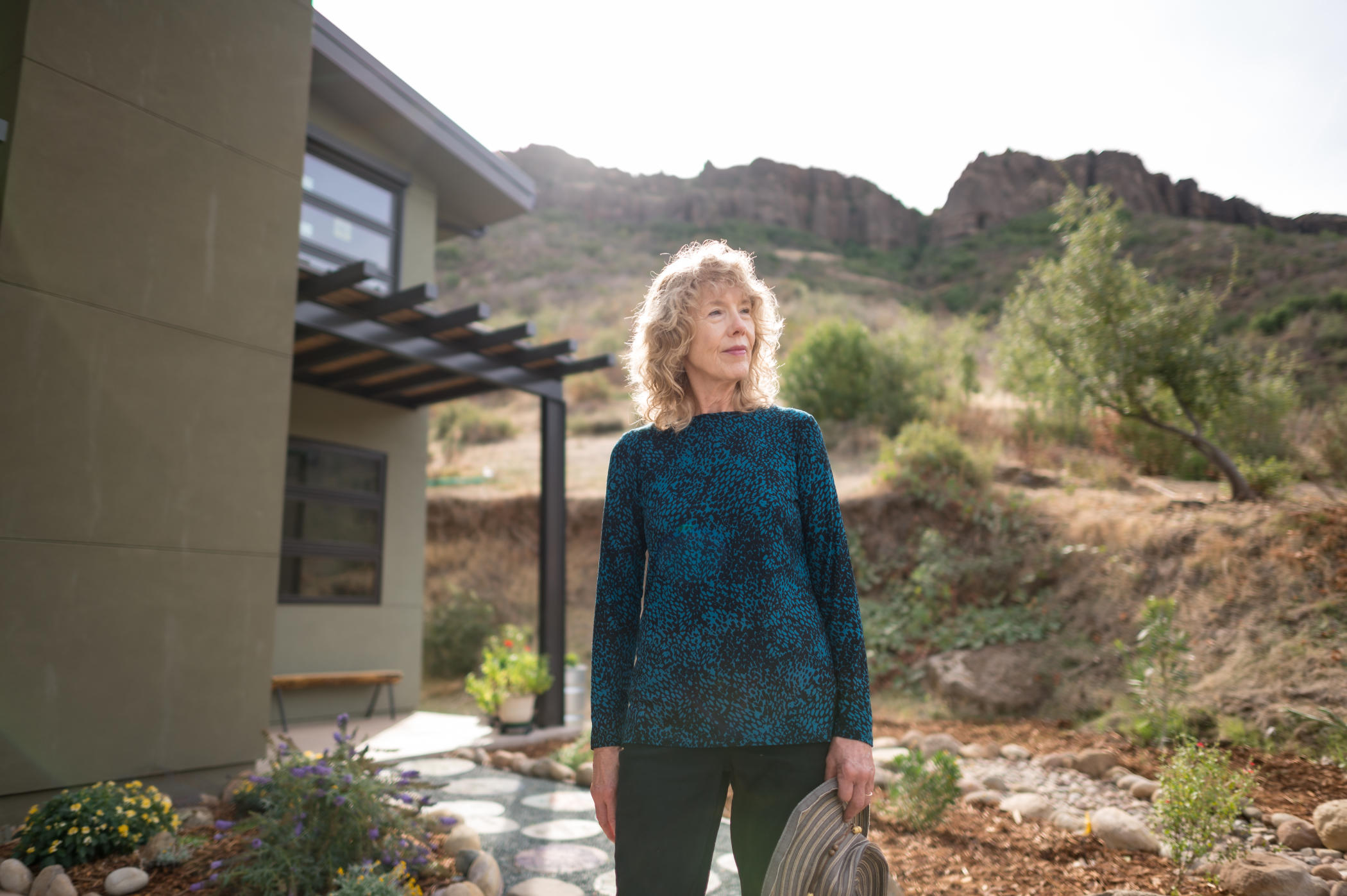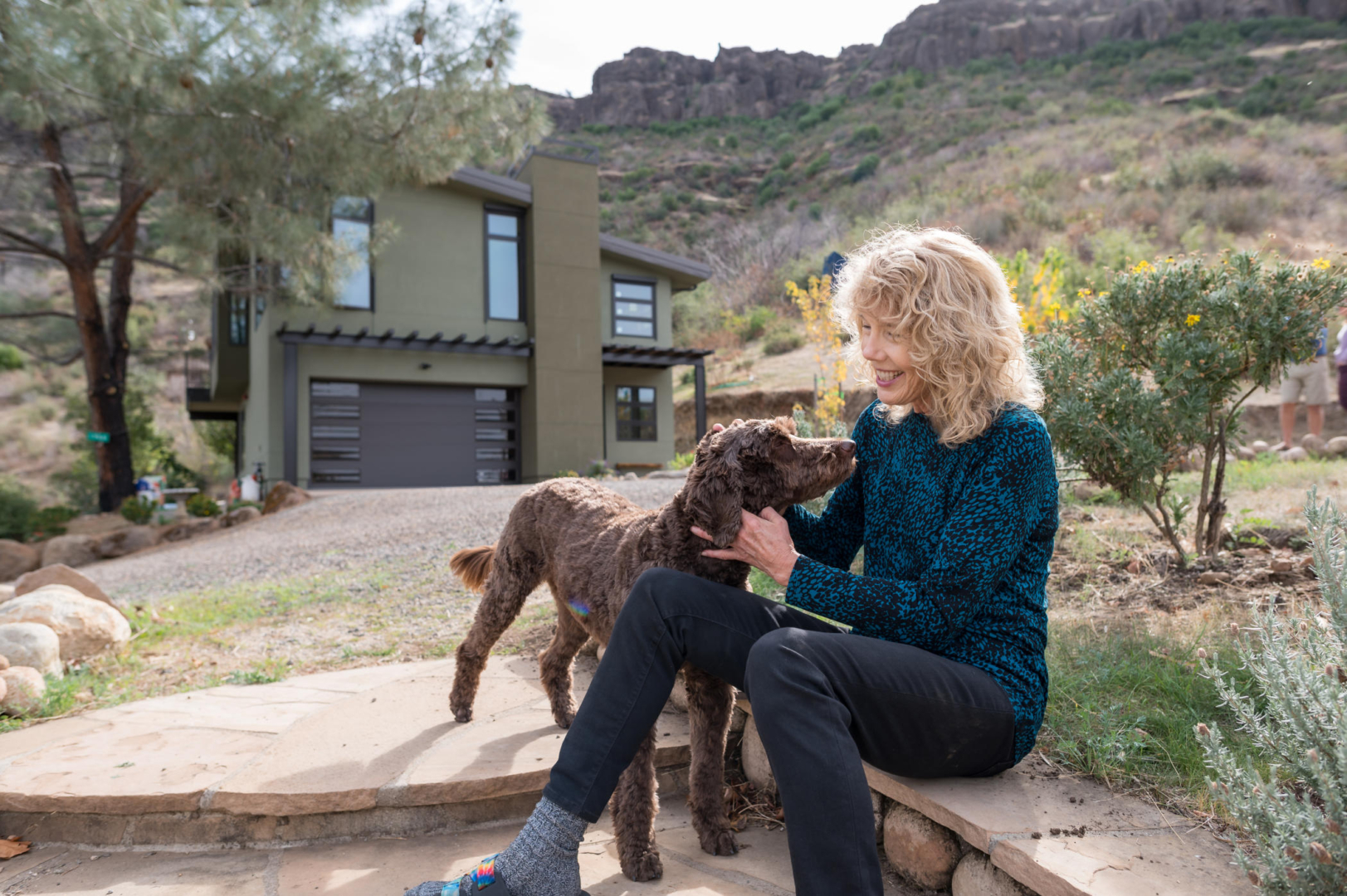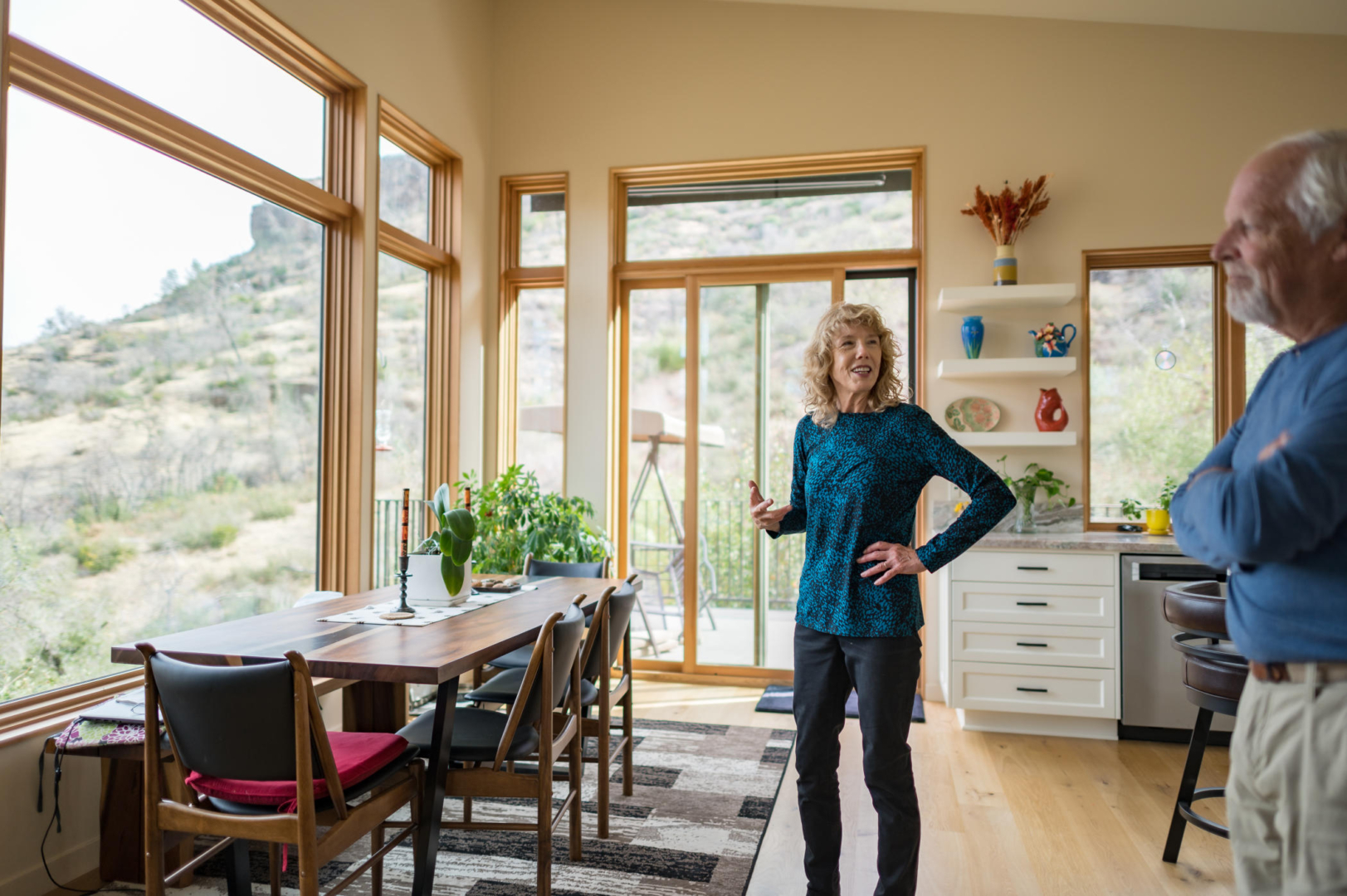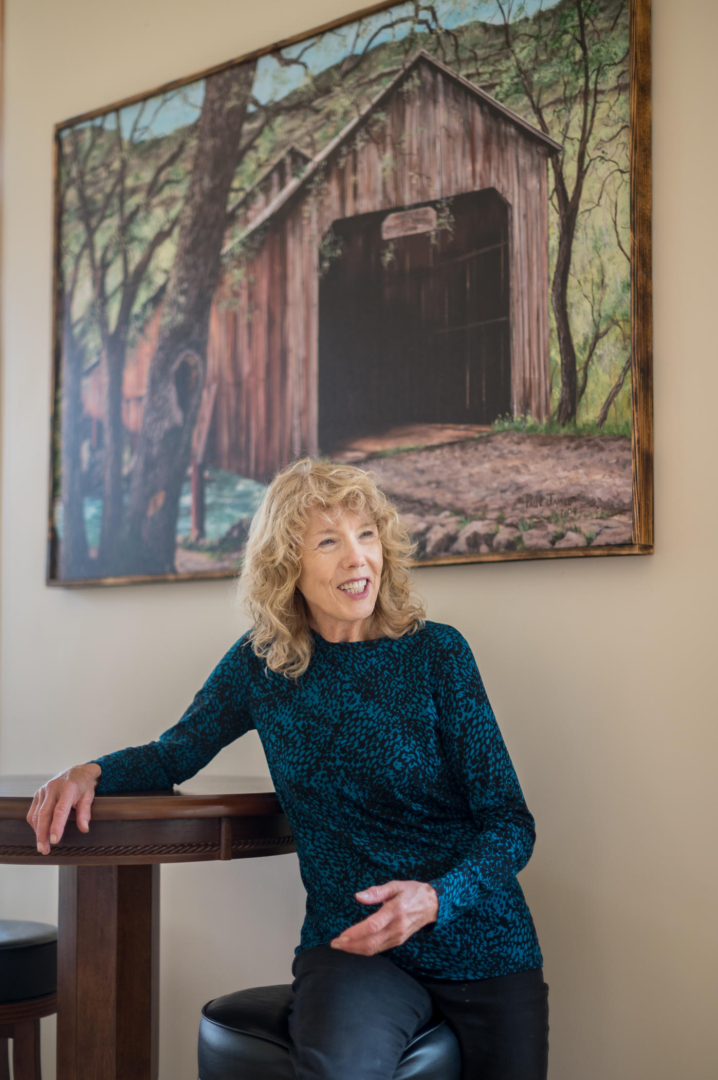Camp Fire Survivor Returns to Rebuilt Home and Hope in Butte Creek Canyon

Cindy Wolff stands outside the front of her newly rebuilt home adjacent to the former burned house on Tuesday, October 25, 2022 in Chico, Calif. Wolff evacuated her Butte Creek Canyon home that burned in the Camp Fire on November 8, 2018. (Jason Halley/University Photographer/Chico State)
Editor’s Note: In 2018, Chico and our greater community were changed forever by the Camp Fire. Among its survivors were 310 students, faculty, and staff at Chico State who lost their homes. For the last four years, we have chronicled Cindy Wolff’s journey as she recovers from a disaster for which there is no guidebook. Here, we do so once more to mark this year’s anniversary.
When the contractors insisted the first order of business was cutting down the gray pine at the edge of the building site, Cindy Wolff adamantly refused.
She planted the evergreen as a seedling 22 years ago and watched it grow taller through the decades. For it to have survived the Camp Fire and remain as a sign of life in the charred canyon, the tree deserves to live—and she needs its presence. Its trunk may be singed, but squirrels still scurry in circles up its trunk and red-headed woodpeckers hop along its branches.
“We water them, we wrap the trunks, every tree is a save,” said Wolff. “If you lived through the fire, you get saved.”
Four years after the deadliest and most devastating wildfire in California history, Wolff hopes to have found a little salvation of her own, in returning with her husband, Steve Hammang, to their Butte Creek Canyon property in June 2022.
As they moved into a newly built two-bedroom, two-bath home—40 years after she first moved onto the property—she draws from the resilient energy of the pine and other remaining vegetation, grafting cuttings of fire survivors into new rosemary plants and oleander bushes to fill the yard with their offspring.
The day they moved in, Wolff, professor emerita in nutrition and food science and retired director of the University’s Center for Healthy Communities, broke into tears. The landscape she had loved for so long is recovering but still looks nothing like the hillsides and valleys so dear to her heart.
In the days and weeks that followed, she’d walk into the kitchen just to find her husband staring out the windows at the unfamiliar landscape. They know it will be a decade or more before it looks anything close to the same, and yet, they look forward to spring, when the golden hills will burst into verdant green and wildflowers carpet the fields.
“The yard is what Steve and I both lived for,” Wolff said. “We didn’t need to replicate a big house. We needed something to appreciate the scenery.”

Steve does all he can to make the property a joy-filled place, installing a swimming pool made from a stock tank, lugging stones from the rock-laden soil to line pathways and guide runoff, and harvesting honey from their beehives on the property.
“She deserves to be happy,” he said.
On the morning of November 8, 2018, when the order to evacuate came in, Wolff gave little thought to the fire’s potential. Having evacuated numerous times through the years, she grabbed their Labradoodle, Scout, some clothes, and a few personal items and fled. When she and Hammang were finally able to return, weeks later, the house she had called home for 36 years was gone. Feeling that her beloved canyon had betrayed her, she vowed never to live there again.
But in time, she and Hammang gave more thought to what the canyon offered—solitude, nature, beauty, and community, one now so much tighter after experiencing the unimaginable—and realized they wanted to return.
“There’s a lot of sad stories, but a lot of good ones, too,” he said.
As they started to plan the design of their new home, they invited a Cal Fire captain to conduct a topographical assessment of the most ideal spot for rebuilding. His first choice, the site of the original home, was a no-go for Wolff. After the death of her first husband there and then witnessing its destruction to the Camp Fire, the next best spot, just uphill, would have to do.
Today, a modern home stands in the driveway of where their old house once stood. Half the size but two stories, it capitalizes as much as it can on a small footprint and was constructed with fire resistance in mind. The exterior has no exposed wood, three layers of stucco, and steel I-beams for support. And there is no propane or natural gas—the entire house is electric, with solar panels to offset their energy demands.
“It’s as fireproof as you can possibly get,” Hammang said.
The danger that once seemed so unlikely to Wolff is now always in their mind. For months, they insisted on a drive-through garage as part of the design plans, despite their builder’s resistance, so they could flee in either direction when the “next” blaze comes.
In time, they were able to compartmentalize their fears and compromise on design, opting to turn the rear of the garage into a studio space for Wolff. Her keyboard sits along a wide window at the base of the pine tree. She can make music while gazing into the beauty of the canyon through the leaves of a fig tree—another fire survivor. Her ukulele and harmonica sit nearby, and strumming tunes or writing poetry fills her with a sense of peace as she looks outward, past the barren spot of their former home and into the valley below.
“My daughter says, ‘Mom, you have to stop calling it the ‘burn scar.’ It keeps that connection in your mind,’” she said. “Maybe in another year we will be able to call it a yard. It just takes a while.”
Longtime gardeners, Wolff and Hammang filled the landscape with plants that attract pollinators, from butterfly bushes to salvia to lantana, that are bringing back the hummingbirds and other wildlife once so prevalent. As she spots a bird on a feeder, a smile spreads across her face.
Residents returning to the canyon are hypersensitive to light and house pollution, they note, so Wolff and Hammang followed suit. The exterior lights, though seldom used, all point downward instead of out toward the starry nights, and the house was painted a shade of green that mimics the needles of Wolff’s beloved gray pine.

“The neighbors tell us they can’t even see the house,” she said.
They call it their “tree house,” as it’s flanked by figs, and a vigorous plum tree that now towers above their second-story deck. From a family of prune farmers, Wolff finds hope in its energy and growth.
The inside of the house is teeming with life of its own. A small but growing collection of books lines a bookcase, and plants adorn nearly every surface. A bowl of pomegranates sits on the kitchen counter and photos of family adorn the fridge.
“We moved back here to figure out our lives,” she said. “We’re not sure what lies ahead of us.”
While that’s certainly not how Wolff pictured her life in retirement, unsettled and facing an uncertain future, she accepts it.
She still doesn’t wear jewelry, admitting it feels fruitless to buy any at the risk of losing it once again. She and Hammang have truly embraced a “less is more” lifestyle.
“Everything is expendable. I can lose it all over again,” she said. “We are much more appreciative of who and what we have.”

Recently, Wolff started reading The Body Keeps the Score and continues to study about the lasting impact of trauma. The fire and their loss have become a part of their identity. When they gather with other survivors—four households just within their family lost homes—it’s something they all talk about, as well as the financial impact.
As they began to outfit the house, the generosity of friends and family came through once again—a carpet from her sister, a couch from a cousin, a bed from her daughter. Wolff knows they are surrounded by the love of those who know they have the strength to start anew and want for them to feel at home once again in the canyon.
When they first received their settlement from PG&E, she was stunned to see they were listed in the “mild trauma” category. Yes, others certainly fared much worse, she said, but the horror of that day was no less real to them and lingers to this day.
And yet, it also created opportunities for growth, including their capacity for empathy, they agree.
“We have so much more depth of understanding of catastrophes,” she said. “And we know the power of the tightness of a community. It’s like you try to take a breath and the community extends its arms and wraps them around you.”
Read the original coverage, and update stories in 2019 and 2020.


